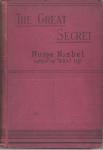AustLit
Latest Issues
AbstractHistoryArchive Description
An ambitious attempt to address current social themes and utopian longings within the framework of a sensational adventure novel, using occult and fantastic literary tropes. These include shipwrecks, castaways on a deserted island, the discovery of an ancient race of subterranians, Bangsian encounters with deceased celebrities, super-weapons and supernatural forces (both good and evil), anarchism, vampiric cannibalism, and considerable low-level Victorian eroticism.
The story begins in the Indian Ocean aboard a luxurious ocean liner. A group of anarchists, led by the mad Dr Fernandez, a scientist and inventor of "infernal" machines of destruction, intend to kill the passengers and crew with a poison gas bomb, hijack the ship, and take it to an island in the Antarctic where they intend to start a colony prior annihilating Europe and then possibly the entrie globe (The Great Secret, 72-71). The plan is foiled, however, when the ship runs aground on an uncharted island during a storm. The anarchists and some surviving passengers (who hid themselves below deck) find a huge cavern which houses the souls of the dead (which resemble huge bats with human faces). Among them are some famous historical figures (including Jesus). 'The story contrasts the sudden violent conversion of society as a whole sought by the anarchist with the gradual voluntary conversion of the individual sought by the religious. As an example, it contrasts a holy communion inside the cave with the unholy communion of two anarchists in a lifeboat who murder a beautiful half-naked woman in the moonlight and take turns drinking her blood until they are sated and fall asleep.' The happier fate of the protagonist, Phillip Mortlock and Ada (the rejected and innocent wife of Fernadez) suggests a return to noble savagery, as well as a Christianity.
[Source: L. W. Currey Inc; John M. Christianson]
Notes
-
While not set in the future, the novel is fundamentally reformational and 'forward-looking' in thought (L.W. Currey, Inc).
-
The term 'Bangsian encounters' refers to a fantasy genre which incorporates famous literary or historical individuals and their interactions in the afterlife.
-
Further Reference:
- Christensen, John M. "New Atlantis Revisited: Science and the Victorian Tale of the Future." Science Fiction Studies # 16 Volume 5, Part 3 (November 1978.- online (sighted 24/5/2012).
- "Nisbet, Hume: The Great Secret." L. W. Currey, Inc. - online (sighted 24/5/2012).
- Christensen, John M. "New Atlantis Revisited: Science and the Victorian Tale of the Future." Science Fiction Studies # 16 Volume 5, Part 3 (November 1978.- online (sighted 24/5/2012).
Publication Details of Only Known VersionEarliest 2 Known Versions of
- Antarctica,




